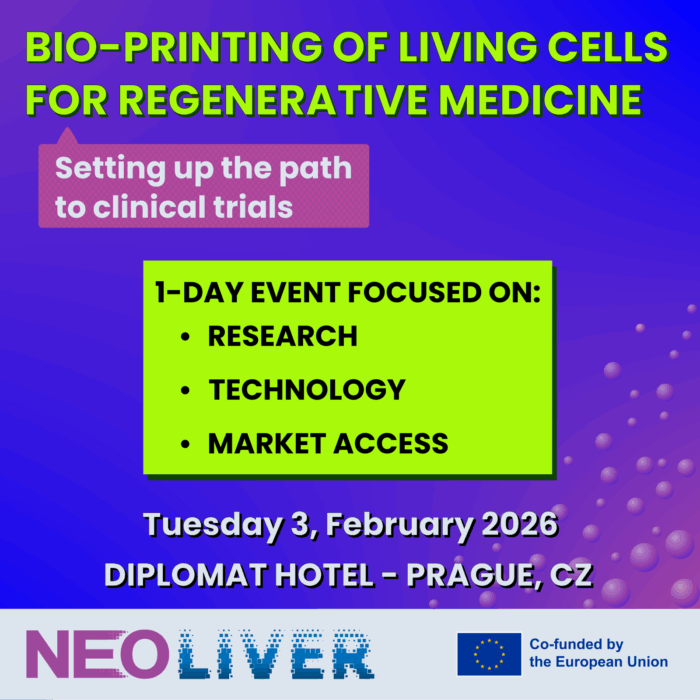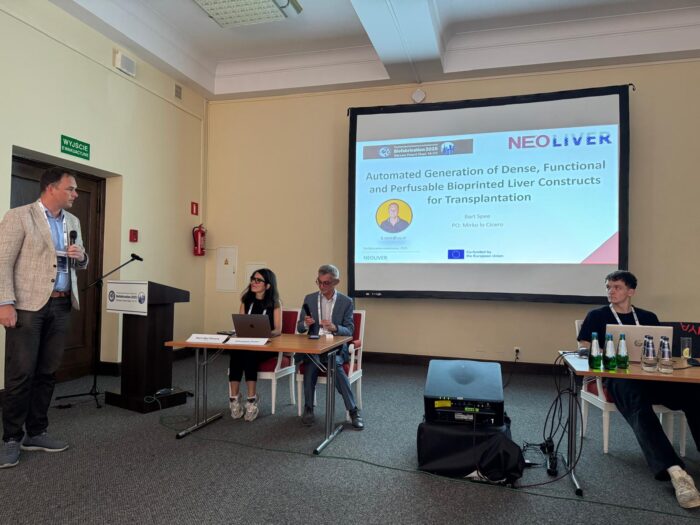NEOLIVER’s First Cluster Activity with EU-funded Projects
Joined forces make bigger movements, and this was the idea behind the symposium Bioprinting approaches in the EU projects, NEOLIVER’s first cluster activity with EU-funded projects. The symposium, organized as part of the International Conference on Biofabrication, brought to Warsaw (Poland) project coordinators from the EU-funded projects under the call HORIZON-HLTH-2024-TOOL-11-02: Bio-printing of living cells for regenerative medicine.
Together with Bart Spee, coordinator of NEOLIVER project, the coordinators of the other five funded projects shared highlights and challenges their projects are currently facing.
Bio-Printing of Living Cells for Regenerative Medicine
- Tentacle – Innovative in situ 4D bioprinting for regeneration of colorectal mucosa and submucosa. The project aims to improve the quality of life and post-operative recovery for CRD patients.
- KeratOPrinter – Advanced 4D printing technologies in corneal regeneration: A pathway to restored vision. The project aims to develop a 4D bioprinting suite, centred around regenerative medicine and tissue engineering.
- LUMINATE – Lighting the way towards in situ osteochondral regeneration through microextrusion and filamented light bioprinting. The project aims to develop a personalised regenerative treatment for large osteochondral lesions, preventing PTOA and avoiding costly surgeries.
- m2M – A bioprinting platform for the rapid, reliable, controlled and quantifiable patterning of cellular aggregates and microtissues into macroscale regenerative grafts with programmable architectures. The project aims to develop a new bioprinting platform capable of spatially patterning numerous cellular aggregates or microtissues into scaled-up, personalised durable load-bearing grafts and guiding their (re)modelling into fully functional tissues in vivo within damaged or diseased environments.
- STRONG-UR – Strategies for Optimised bioprinting of Next Generation tissues for urethral regeneration and translation. The project aims to develop bioprinted tubular tissue constructs for urethral tissue engineering. It will create modular, scalable bioprinter components and smart bioinks that can be personalised for individual constructs, enabling noninvasive monitoring and real-time treatment assessments.
- NEOLIVER – Automated generation of dense, functional and perfusable bioprinted liver constructs for Transplantation. The project aims to develop large, dense, and vascularized fully functional bioprinted constructs suitable for transplantation.
Takeaways from the Cluster Activity
This first cluster activity not only showcased the scientific ambition and diversity of the six EU-funded bioprinting projects, but also underscored a shared concern: the urgent need for continued dialogue around bioprinting regulation in Europe. As the field advances rapidly, clear, harmonized regulatory frameworks are essential to ensure safety, scalability, and clinical translation. The symposium created a valuable space for project coordinators and European Health and Digital Executive Agency (HaDEA) representatives to exchange perspectives, but it also highlighted that this conversation must remain active and evolve alongside the technologies.

Continuing the Conversation in Prague
Building on the momentum of this first cluster activity, NEOLIVER is preparing to continue the conversation around bioprinting regulation and clinical translation. The upcoming IV Regenerative Medicine Workshop, taking place on 3 February 2026 in Prague, will focus on bridging the gap between cutting-edge research and clinical trials in the field of bio-printing of living cells. With sessions covering EU-funded research, breakthrough technologies for scalable bioprinting, IP strategies, regulatory frameworks, and opportunities for cross-European collaboration, the workshop offers a natural continuation of the discussions initiated in Warsaw.
NEOLIVER remains committed to shaping a supportive regulatory landscape for bioprinting innovation through ongoing dialogue and collaboration.

